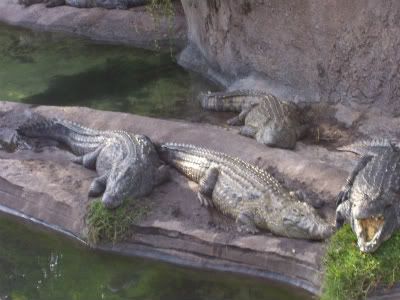
DRESSED IN A SUIT OF BONY PLATES and looking like an armoured tank, the Nile crocodile could be a creature from prehistoric times. With a long tail used to propel it at speed through the water and large jaws, lined with 60 or so pointed teeth, this reptile is a lethal hunting machine. Despite its name, the nile crocodile is found in most of Africa. Living in lakes, rivers and swamps - and sometimes along beaches and even 10 km out to sea - these crocodiles seldom venture far from water. Only if their pool dries up will they trek overland in search of a new aquatic home.
Crafty Predator
Crocodiles are meat-eaters, taking fish, turtles, and any mammal including zebra, young hippos, big cats, and even people. Hatchlings eat small prey like frogs and insects. Adult use a range of hunting techniques, from rushing at prey to herding schools of fish into bays with their tails. They also lie in wait near the shore, with only their eyes above water, waiting for animals to come to drink. The unwary fall victim to a sudden lunge in which the crocodile seizes the prey's head between its huge jaws, or fells it with a whip-like blow of the tail. To feed, it rolls over in the water with its prey until a piece of the animal's fleshis torn off. Amazingly, the Nile crocodile can go without food for up to a year.
Prized for its Skin
The Nile crocodile exists in healthy numbers in most of its range, but is very rare in Egypt and under pressure in West Africa. In South Africa an introduced invasive plant known as the 'trifid weed' ( Chromolaena odorata ) is causing crocodiles to abandon nesting sites. More general threats include river pollution and poachers who kill the crocodile for its skin, which is used for fine leather. Crocodiles are also hunted where they are perceived as a threat to people and farm animals, despite the fact that they have legal protection in some African countries.
Crocodile Creche
For such a fierce-looking creature, the female crocodile is a remarkably caring mother. After mating, she digs a nest in a sandy bank and lays an average of 50 eggs, which are incubated by rotting vegetation in the nest. She stays nearby to deter predators. When the eggs hatch, the babies call for their mother, making chirping noises loud enough to be heard through the sand covering the nest. The female digs them out and carries them in her mouth to nearby water. Hatchlings stay in a 'creche' with the juveniles of the previous season, protected by the female. The young do not leave the family group until they are about two years old.
Group Living
Mature adults live in groups that range from 20 or 30 to several hundred. There is a strict hierarchy. Larger dominant males drive smaller males away from potential mates, but there is surprisingly little fighting. Crocodiles bask on the banks in the morning, with their mouths open to let excess heat escape. They allow small birds, such as the spur-winged plover, to pick trapped meat from between their teeth. By noon, crocodiles return to the water to hunt. They often swallow stones as ballast, so they will float lower down in the water and be less obvious to animals on the banks.
STATISTICS
Status : Common
Length : 3.5 - 6 m (11 20 ft)
Weight : Up to 900 kg (1,980 lb)
Habit : Mostly aquatic
Sexual Maturity : 8 - 12 years
Incubation Period : 80 - 90 days average
Number Of Eggs : 50 average; up to 100 recorded
Diet : Fish and turtles, mammals from small monkeys and antelope to young big cats and humans
Lifespan : 70 - 100 years




0 comments:
Post a Comment